
Peristaltic Pumps Market
Peristaltic Pumps Market By Type (Tube Pumps & Hose Pumps), Flow Rate, End-use Industry (Pharmaceuticals, Food & Beverages, Water & Wastewater Treatment, Chemical Processing, Mining, Pulp & Paper) and Region - Global Forecast to 2030




OVERVIEW
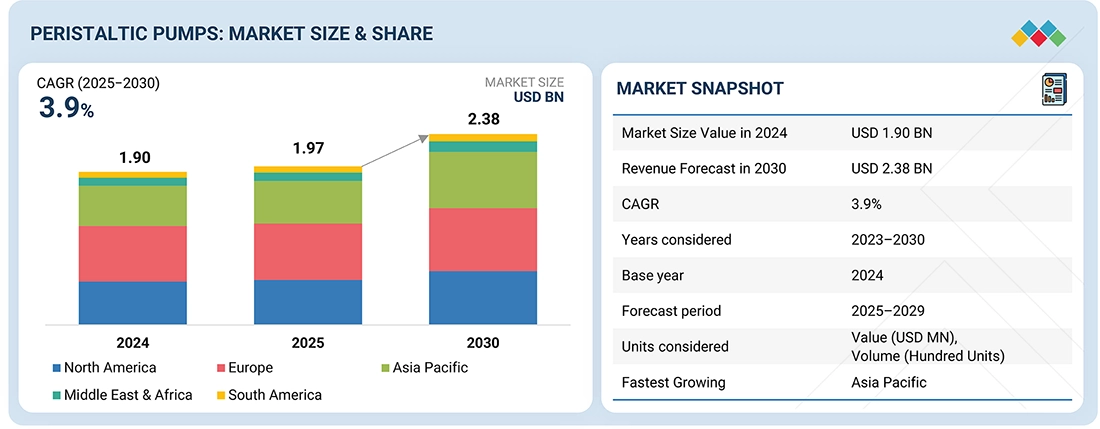
Source: Secondary Research, Interviews with Experts, MarketsandMarkets Analysis
The peristaltic pumps market is expected to reach USD 2.38 billion in 2030 from USD 1.97 billion in 2025, registering a CAGR of 3.9% during the forecast period. The market for peristaltic pumps is expanding rapidly worldwide due to a number of interrelated factors. Reliable and accurate fluid handling solutions are being adopted by industries due to stringent wastewater treatment regulations and growing capacity additions. Parallelly, growing investments worldwide in new plants for water & wastewater treatment have given a further push to demand, as peristaltic pumps would offer low maintenance operations and are utilized for a wide range of fluid types.
KEY TAKEAWAYS
- Peristaltic hose pumps and peristaltic tube pumps are the two categories of peristaltic pumps considered under the type segment. The the tube pumps segment held the largest share of the global peristaltic pumps market, driven by their versatility, cost-effectiveness, and ease of maintenance.
- Peristaltic pumps based on flow rates are categorized into Below 1000 ml/min, 1000 ml/min - 2000 ml/min, and Above 2000 ml/min. The below 1000 mL/min flow rate category became the prominent segment in the peristaltic pumps market worldwide due to its accuracy, control, and adaptability toward low-volume dosing applications.
- Pharmaceutical & medical, water & wastewater treatment, chemical processing, mining, food & beverage, and pulp & paper are the major end-use industries of peristaltic pumps. The pharmaceuticals segment held the largest share of the global peristaltic pumps market in 2024, driven by the critical need for precise, sterile, and contamination-free fluid handling in drug manufacturing and research.
- The market for peristaltic pumps is segmented into North America, Europe, Asia Pacific, the Middle East and Africa, and South America, based on regions. Due to stringent regulations, sophisticated healthcare infrastructure, and robust demand from the biotechnology and pharmaceutical industries, Europe held the largest share of the global peristaltic pump market in 2024.
- The market is driven by strategic acquisitions, product launches, and expansions from leading players such as are Watson-Marlow Fluid Technology Solutions (UK), Verder Group (Netherlands), ProMinent Group (Germany). These companies are investing in product innovations and conducting acquisitions that help them increase regional presence and differentiate themselves in the market.
The market is observing consistent growth on account of the increasing demand from sectors such as pharmaceuticals, water & wastewater treatment, food & beverage, and chemical processing. Higher focus on hygienic fluid handling, accurate dosing, and contamination-free transfer is encouraging their adoption. Innovation in pump technology, growing industrial automation, and increasing applications in healthcare and biotechnology are additional drivers for market growth.
TRENDS & DISRUPTIONS IMPACTING CUSTOMERS' CUSTOMERS
Changes in customer trends or disruptions impact consumers’ businesses. These shifts impact the revenues of end users. Consequently, the revenue impact on end users is expected to affect the revenues of peristaltic pump suppliers, which, in turn, impacts the revenues of peristaltic pump manufacturers.
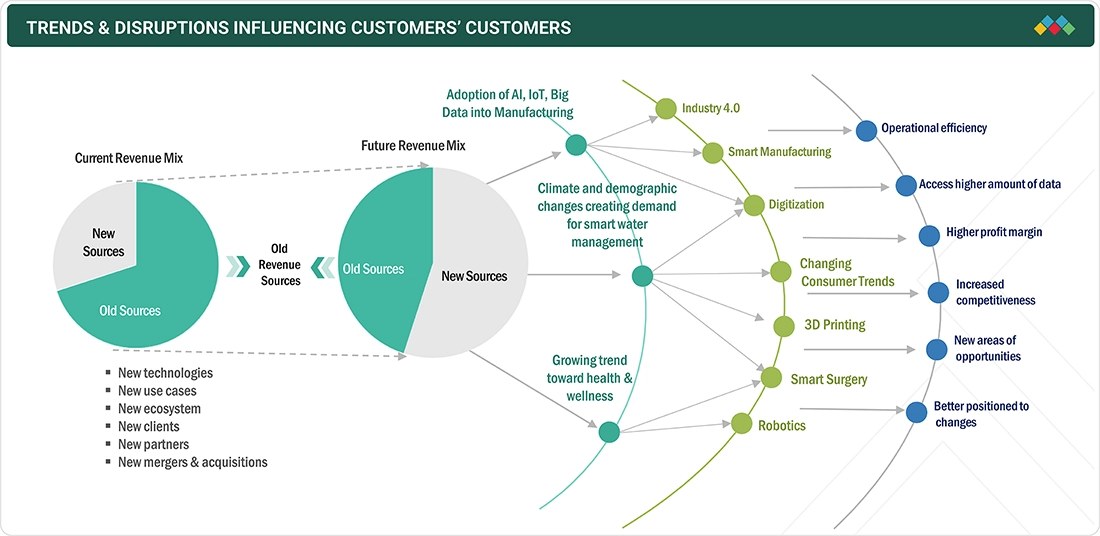
Source: Secondary Research, Interviews with Experts, MarketsandMarkets Analysis
MARKET DYNAMICS
Level
-
Stringent regulations for wastewater treatment and increasing capacity additions

-
Increasing global investment in new water and wastewater treatment facilities
Level
-
Availability of large numbers of alternatives
-
Fluctuations in raw material prices
Level
-
Smart technologies in peristaltic pumps
-
Rising capacity expansions and joint venture initiatives by end users in fast-growing markets
Level
-
Growing demand for customization from end-use industries
-
Low scope of product differentiation
Source: Secondary Research, Interviews with Experts, MarketsandMarkets Analysis
Driver: Stringent regulations for wastewater treatment and increasing capacity additions
According to the UN World Water Development Report, the manufacturing sector currently uses 19% of freshwater, a figure projected to rise to 24% by 2050. In response, the Sustainable Development Goal (SDG) 6.3 aims to improve water quality by 2030 by reducing pollution, eliminating dumping, and increasing the proportion of safely treated wastewater. The UN informs that the global water crisis has worsened despite the fact that 2.2 billion individuals lack access to safe drinking water and annual water usage rises by 1%. The environment is facing severe ecological and health risks since over 80% of wastewater flows into the environment without being subjected to proper treatment. SDG Indicator 6.3.1 illustrates nations' abilities to treat household and industrial wastewater, emphasizing decentralized water filtration systems. World interest in water treatment technologies is increasing, contributing to the higher demand for peristaltic pumps due to the performance of pumps in meeting prevailing sanitation requirements effectively. Through their design, these pumps deliver chemical dispensing along with sludge transfer and fluid management without any risk of contamination. The worldwide expansion of industrial wastewater systems, together with municipal water treatment facility upgrades, will accelerate the growth of the peristaltic pumps market in areas facing water quality challenges and regulatory requirements.
Restraint: Availability of large numbers of alternatives
Peristaltic pumps constitute a sub-class of positive displacement (PD) pumps, which are one of the two main categories of pumps: centrifugal and positive displacement. PD pumps are used in plants that involve medium flow-rate applications, while centrifugal pumps are commonly used in plants with high flow-rate applications. Sometimes it has been seen that if a plant in an industry already uses centrifugal pumps installed on its estate, utilizing the same pumps for even applications calling for medium rates of flow could be more cost-effective due to their simple construction, quick maintenance, and low cost. On the other hand, numerous types of PD pumps are available for industrial applications. For instance, in the pump industry, PD pumps, such as gear pumps, lobe pumps, and peristaltic pumps, can all be utilized for the same applications. However, end users who are uninformed of the specific pumps required, install any kind of pump that is readily available to them. Due to the abundance of alternatives for peristaltic pumps in the market, manufacturers face difficulties tapping into the potential industrial end-use market, which results in lower revenue generation from the sale of industrial peristaltic pumps, especially given that end users have a large selection of pumps to choose from.
Opportunity:Rising capacity expansions and joint venture initiatives by end users in fast-growing markets
The industrial sector has experienced rapid expansion in emerging economies and stable growth in developed/mature markets over the past ten years. Industry participants are eager to meet demand in emerging economies. Key market players are implementing techniques, such as joint ventures and expansions, to boost their production capacities, strengthen their competitiveness, and achieve increasing market penetration in high-growth regions, including the Asia Pacific. Rapid industrialization, rising living standards, a sizable population, and accessibility to cheap labor in the Asia Pacific have encouraged companies to establish their facilities and meet consumer needs in the region. Demand for peristaltic pumps is anticipated to increase due to the expected launch of new production facilities during the forecast period. For instance, Watson-Marlow is continuing to expand geographically by establishing new sales and trading companies in the Philippines, Colombia, and Iberia (Spain and Portugal). This will enable Watson Marlow to strengthen its service network across these countries. Graco has announced the purchase of a 20-acre piece of land close to the company's current Anoka facility. The purchased property is situated northwest of Graco and south of Bunker Lake Boulevard. These developments are expected to significantly boost the peristaltic pumps market, reinforcing its role as a critical component in industrial growth and the development of modern infrastructure.
Challenge:Frequent hose or tube replacements
The operation of peristaltic pumps involves squeezing flexible tubes to advance fluid through their systems, which creates limitations on both, pressure levels and flow velocity. The primary usage of peristaltic pumps occurs in systems that operate below 8-16 bar pressure because centrifugal and positive displacement pumps are more suitable for high-pressure applications. Moreover, peristaltic pumps naturally exhibit pulsating flow characteristics and are generally used for applications requiring accurate dosing or metering of fluids as opposed to continuous high-volume transfer. This limitation is a major problem in applications involving high-throughput, high-pressure fluid handling, e.g., oil & gas, power generation, or large chemical processing. Under such conditions, the performance limitations of peristaltic pumps make them ineffective as main fluid transport systems. Even in applications where peristaltic pumps are technically suitable, operators require installing several units in parallel or employing them on short-duty cycles to achieve increased capacity requirements, increasing expenditures and complexities. Consequently, though their benefits to hygiene, contamination control, and maintenance are apparent, the limitation of pressure and flow capacities of peristaltic pumps continues to be the main limitation to wider industrial application.
Peristaltic Pumps Market: COMMERCIAL USE CASES ACROSS INDUSTRIES
| COMPANY | USE CASE DESCRIPTION | BENEFITS |
|---|---|---|
 |
Use of peristaltic pumps to improve detergent dispensing in washing machines, reducing water wastage and environmental impact. | Optimized detergent use and reduced water wastage, improved detergent dosing accuracy, environmentally friendly with energy savings. |
 |
Upgrade to Verderflex Dura 65 Hose Pumps for consistent lime slurry flow and reduced maintenance. | Reduced downtime and maintenance costs, simplified maintenance with hose replacement, increased operational efficiency and reduced lifecycle costs. |
 |
Upgrade from outdated diaphragm pumps to FLEXFLO M3 peristaltic pumps to reduce energy and maintenance costs at Lompoc City Water Treatment Plant. | 710% reduction in energy costs (approx. USD 1,775 annually), simplified maintenance with only periodic tube replacements, improved operational efficiency and reliability. |
Logos and trademarks shown above are the property of their respective owners. Their use here is for informational and illustrative purposes only.
MARKET ECOSYSTEM
The peristaltic pumps market ecosystem includes raw material suppliers, peristaltic pump manufacturers, distributors, and end users. Raw material suppliers offer major components, such as tubing, motor, rotor, roller shoes, and other components. Peristaltic pumps manufacturers produce peristaltic pumps of different types to meet the needs of numerous end-use industries without compromising regulatory requirements. Distributors bring market access through a proper supply chain. The pharmaceuticals, water & wastewater management, food & beverages, mining, chemical processing, and pulp & paper industries employ peristaltic pumps for precise fluid handling, dosing, and transfer applications
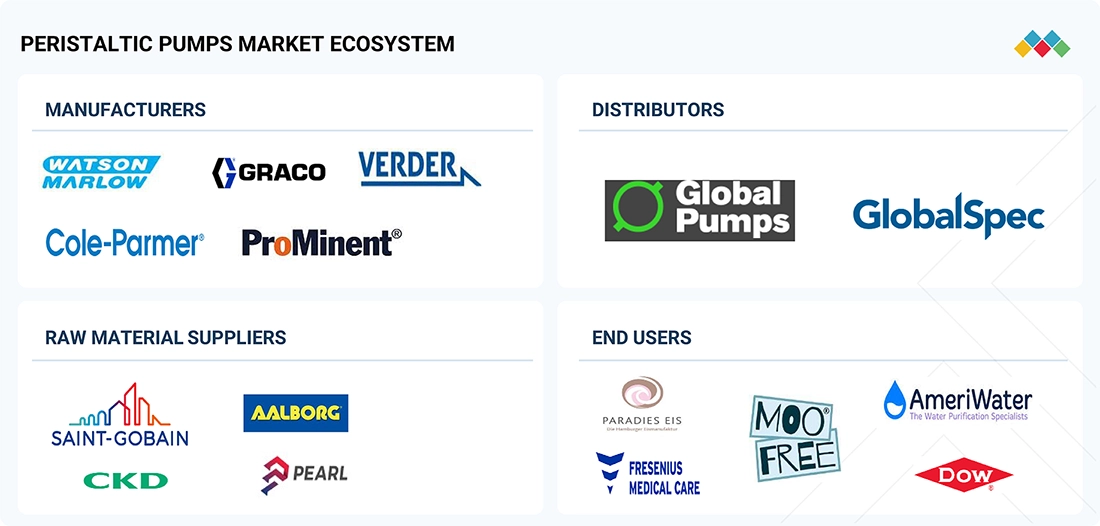
Logos and trademarks shown above are the property of their respective owners. Their use here is for informational and illustrative purposes only.
MARKET SEGMENTS
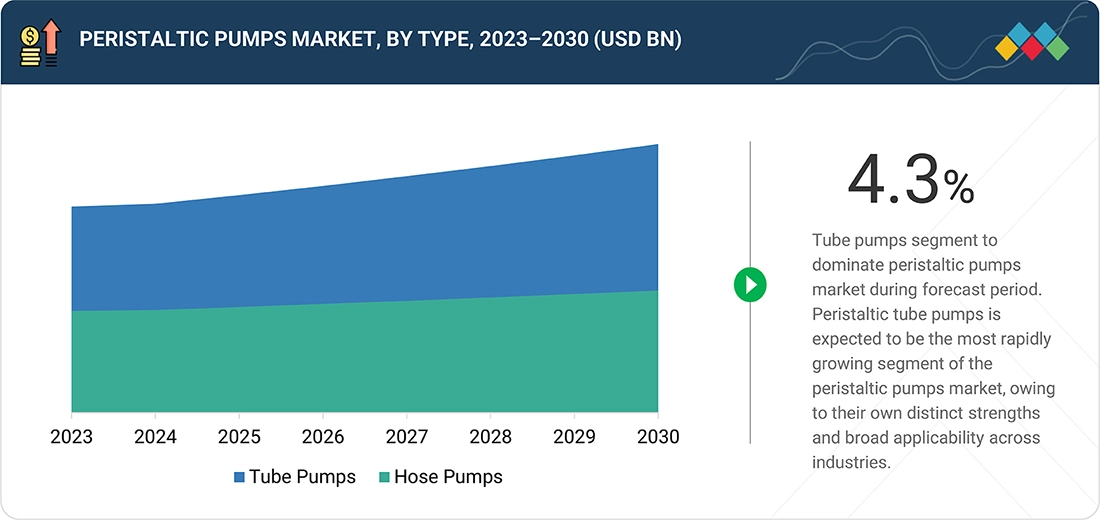
Source: Secondary Research, Interviews with Experts, MarketsandMarkets Analysis
Peristaltic Pumps Market, By Type
Peristaltic tube pumps is expected to be the most rapidly growing segment of the peristaltic pumps market, owing to their own distinct strengths and broad applicability across industries. They are best suited for low-pressure, precise manipulation of fluid in a clean setting, and thus are most appropriate for use in sterile, contamination-sensitive operations. The high growth of the market for tube pumps is attributed to their own special capability of handling shear-sensitive fluids without being damaged, as well as their accurate dosing. The process remains contaminant-free because the fluid only comes into contact with the tube's interior. This is particularly crucial in areas where contamination control is unassailable. Their simple, robust design and the lack of complex moving parts contribute to reduced downtime and lower operational costs, making them cost-effective for industries with continuous, high-volume operations. Since peristaltic tube pumps need tube replacements only intermittently, they are characterized by highly accurate performance and low requirements for maintenance. Due to its accuracy, reliability, and convenience for maintenance, the peristaltic tube pump is currently the best the industry has for fluid management.
Peristaltic Pumps Market, By Flow Rate
In 2024, the below 1000 mL/min flow rate category became the prominent segment in the peristaltic pumps market worldwide due to its accuracy, control, and adaptability toward low-volume dosing applications. When precise and contamination-free fluid management is required, the pump is utilized in the biotechnology, pharmaceutical, medical device, and laboratory sectors. They are ideal for sensitive operations such as the mixing of chemicals for sampling, dosing reagents, and transferring cell culture media due to their ability to provide accurate flow rates. Their minimal maintenance requirements and compact size make them even more desirable in space-restricted settings.
Peristaltic Pumps Market, By End-use Industry
The pharmaceuticals segment held the largest share of the global peristaltic pumps market in 2024, driven by the critical need for precise, sterile, and contamination-free fluid handling in drug manufacturing and research. Peristaltic pumps are widely used for dosing active pharmaceutical ingredients (APIs), transferring sensitive solutions, and filling sterile containers due to their gentle, non-contact operation. In alignment with the pharmaceutical industry's shifting inclination toward precision, automation, and safety, an upswing in the peristaltic pumps market is expected. Besides handling fluids of varying viscosities, their design enables easy cleaning-in-place (CIP), sterilizing-in-place (SIP) operations, and ensures product purity, making their utility excellent in pharmaceutical manufacturing processes.
REGION
Asia Pacific to be fastest-growing region in global Peristaltic Pumps market during forecast period
The Asia Pacific region is projected to be the fastest-growing market for peristaltic pumps, supported not only by industrial expansion but also by active government involvement in key sectors. Government agencies across countries such as China, India, and Southeast Asian nations are implementing stricter regulations and offering funding initiatives to improve water quality, public health, and industrial efficiency. China's Five-Year Plans, for example, stress wastewater management and the availability of clean water, which drives higher investments in treatment infrastructure wherein sludge handling and chemical dosing call for peristaltic pumps. Additionally, food safety regulations are tightening across the region, prompting food & beverage companies to adopt hygienic, precise dosing technologies. Beneficial policies such as India's Production Linked Incentive (PLI) plan and China's self-sufficiency drive to manufacture drugs domestically are promoting indigenous production and the adoption of advanced process technologies in drug and biotech manufacturing. Proven fluid handling systems experience improved marketplace acceptance while government programs fund local production with sustainability programs alongside assisting industrial automation. The Asia Pacific peristaltic pumps market is propeling growth due to the strong regulatory support and increasing industrialization and government infrastructure expenditures.
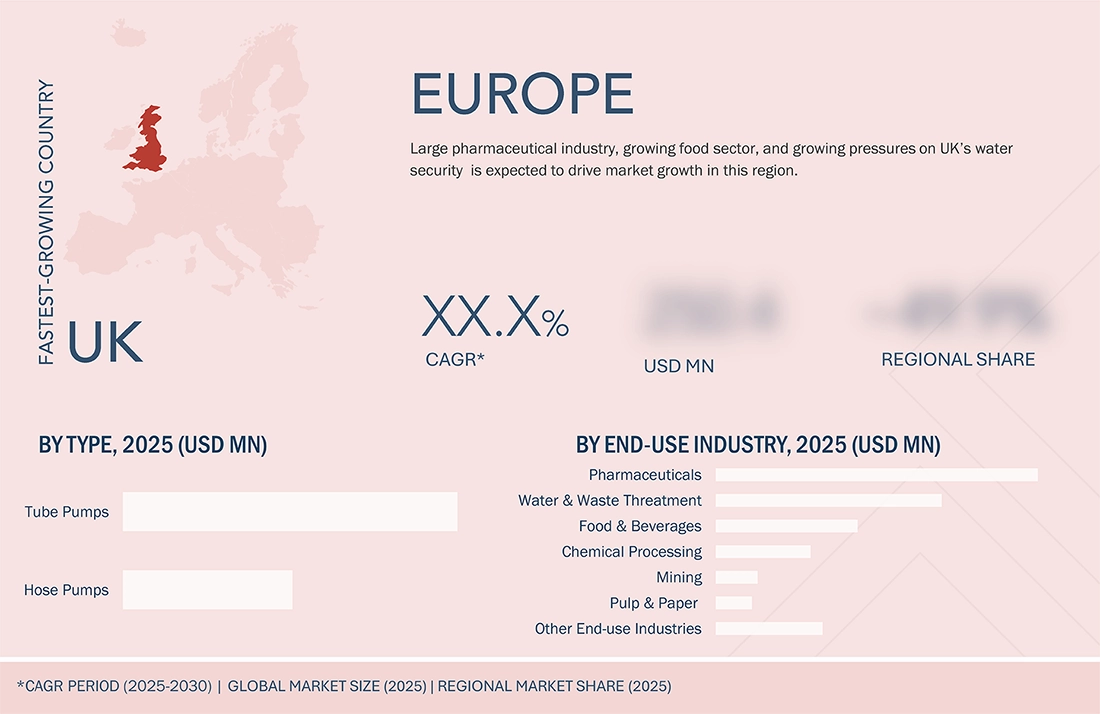
Peristaltic Pumps Market: COMPANY EVALUATION MATRIX
In the Peristaltic Pumps market matrix, Watson-Marlow Fluid Technology Solutions (Star)specializes in peristaltic and niche pumps, and is associated with fluid path technologies, serving various industries, such as life sciences, pharmaceutical & biotechnology, food & beverage, mining, automotive, and other process industries.The business now serves more than 60 markets in North America, South America, Asia Pacific, Europe, the Middle East, and Africa, in addition to running ten cutting-edge manufacturing facilities. Graco Inc. (Emerging Leader) is a leading provider of advanced pumps and spray equipment for fluid handling, specializing in the development, production, and sale of systems designed to move, measure, control, dispense, and spray both, fluid and powder materials. WhileWatson-Marlow Fluid Technology Solutions dominates with scale, Graco Inc. shows strong growth potential to advance toward the leaders’ quadrant.
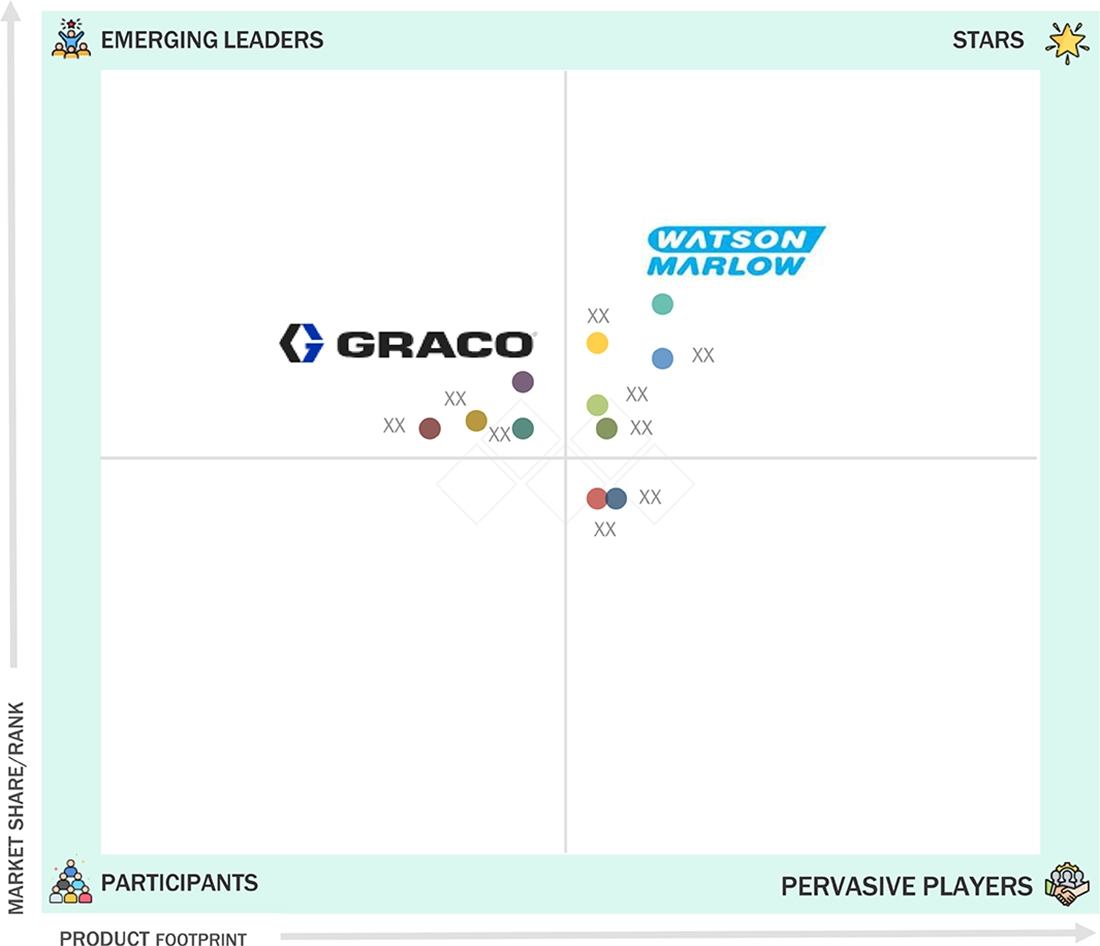
Source: Secondary Research, Interviews with Experts, MarketsandMarkets Analysis
KEY MARKET PLAYERS
MARKET SCOPE
| REPORT METRIC | DETAILS |
|---|---|
| Market Size in 2024 (Value) | USD 1.90 Billion |
| Market Forecast in 2030 (value) | USD 2.38 Billion |
| Growth Rate | CAGR of 3.9% from 2024-2029 |
| Years Considered | 2023–2030 |
| Base Year | 2024 |
| Forecast Period | 2025–2030 |
| Units Considered | Value (USD Million), Volume (Hundred Units) |
| Report Coverage | Revenue forecast, company ranking, competitive landscape, growth factors, and trends |
| Segments Covered |
• By Type: Tube Pumps, Hose Pumps; By Flow Rate: Below 1000 ml/min, 1000 ml/min - 2000 ml/min, and Above 2000 ml/min • By Application: Pharmaceutical & medical, water & wastewater treatment, chemical processing, mining, food & beverage, and pulp & paper, Other Applications |
| Regions Covered | Europe, North America, Asia Pacific, the Middle East & Africa, and South America |
WHAT IS IN IT FOR YOU: Peristaltic Pumps Market REPORT CONTENT GUIDE
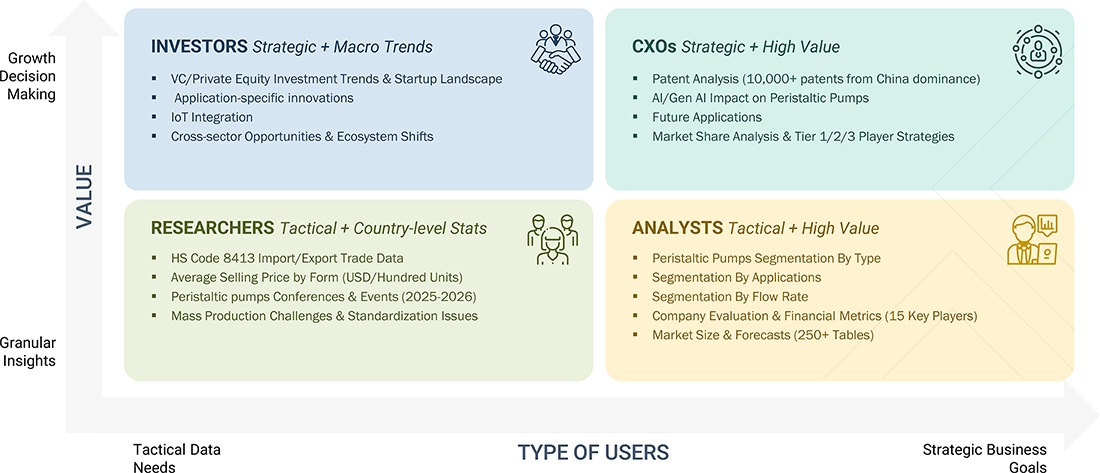
DELIVERED CUSTOMIZATIONS
We have successfully delivered the following deep-dive customizations:
| CLIENT REQUEST | CUSTOMIZATION DELIVERED | VALUE ADDS |
|---|---|---|
| Deep Dive into Europe Peristaltic Pumps Market | • Detailed breakdown of Europe market into UK, Germany, France, Italy • Further breakdown of type segment for each country, and end-use industry | • Insights into countries from Europe and potential market for Peristaltic Pumps • Identification of future growth opportunities and investments |
RECENT DEVELOPMENTS
- March 2025 : Bredel, part of Watson-Marlow Fluid Technology Solutions, launched the new Bredel Heavy Duty pump designed for the mining and construction sectors
- February 2025 : Valmet established a stronger presence in the US automation business through its partnership with Trident Automation, Inc.
- October 2024 : Verder Liquids, a division of the Verder Group, launched the VERDERFLEX DURA 60, a high-performance peristaltic pump intended for industrial use.
- September 2024 : Verder Group, a global leader in advanced pumping and scientific solutions, acquired Sauermann, a prominent supplier in the HVAC-R market.
- April 2024 : Cole-Parmer Instrument Company, LLC, expanded its operations by re-entering the fluid handling market with a renewed product line
Table of Contents

Methodology
The study involved four major activities to estimate the current size of the global peristaltic pumps market. Exhaustive secondary research was carried out to collect information on the market, the peer product market, and the parent product market. The next step was to validate these findings, assumptions, and sizes with industry experts across the value chain of peristaltic pumps through primary research. The top-down and bottom-up approaches were employed to estimate the overall size of the peristaltic pumps market. After that, market breakdown and data triangulation procedures were used to determine the size of the different segments and subsegments of the market.
Secondary Research
The market for companies offering peristaltic pumps is arrived at through secondary data available through paid and unpaid sources, analyzing the product portfolios of the major companies in the ecosystem, and rating the companies in terms of their performance and quality. Various secondary sources, such as Business Standard, Bloomberg, World Bank, and Factiva, were referred to identify and collect information for this study on the peristaltic pumps market. In the secondary research process, various secondary sources were referred to identify and collect information related to the study. Secondary sources included annual reports, press releases, and investor presentations of peristaltic pumps vendors, forums, certified publications, and white papers. Secondary research was used to obtain critical information on the industry’s value chain, the total pool of key players, market classification, and segmentation from the market and technology-oriented perspectives.
Primary Research
In the primary research process, various primary sources from both, the supply and demand sides were interviewed to obtain qualitative and quantitative information for this report. The primary sources from the supply side included industry experts, such as Chief Executive Officers (CEOs), Vice Presidents (VPs), marketing directors, technology and innovation directors, and related key executives from several key companies and organizations operating in the peristaltic pumps market. After the complete market engineering (calculations for market statistics, market breakdown, market size estimations, market forecasting, and data triangulation), extensive primary research was conducted to gather information and verify and validate the critical numbers arrived at. Primary research was also conducted to identify the segmentation types, industry trends, competitive landscape of peristaltic pumps offered by various market players, and key market dynamics, such as drivers, restraints, opportunities, challenges, industry trends, and key player strategies. In the complete market engineering process, the top-down and bottom-up approaches and several data triangulation methods were extensively used to perform the market estimation and market forecasting for the overall market segments and subsegments listed in this report. Extensive qualitative and quantitative analysis was performed on the complete market engineering process to list key information/insights throughout the report.
Following is the breakdown of interviews with experts:
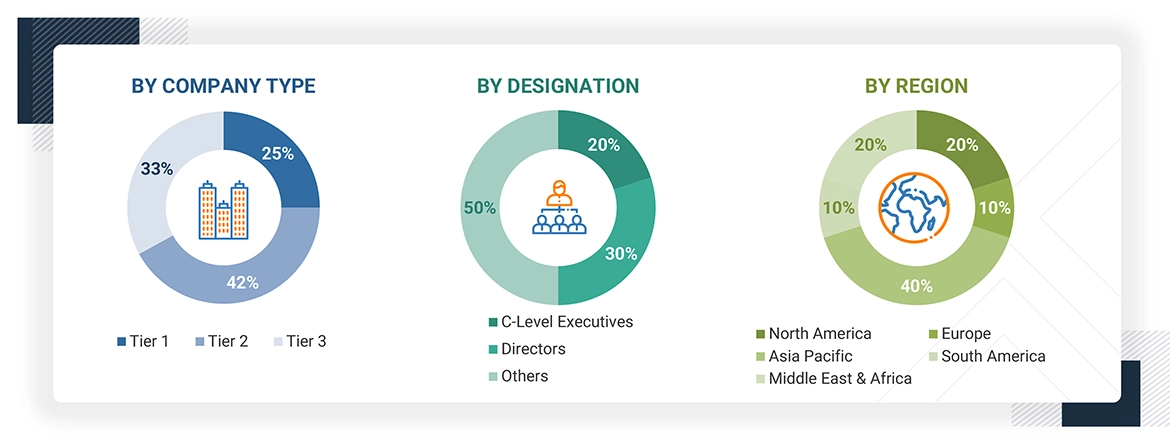
Note: Other designations include sales, marketing, and product managers.
Tier 1: >USD 1 Billion; Tier 2: USD 500 Million–1 Billion; and Tier 3: < USD 500 Million.
To know about the assumptions considered for the study, download the pdf brochure
Market Size Estimation
The top-down and bottom-up approaches were used to estimate and validate the size of the global peristaltic pumps market. These approaches were also used extensively to estimate the sizes of various dependent market segments. The research methodology used to estimate the market size included the following:
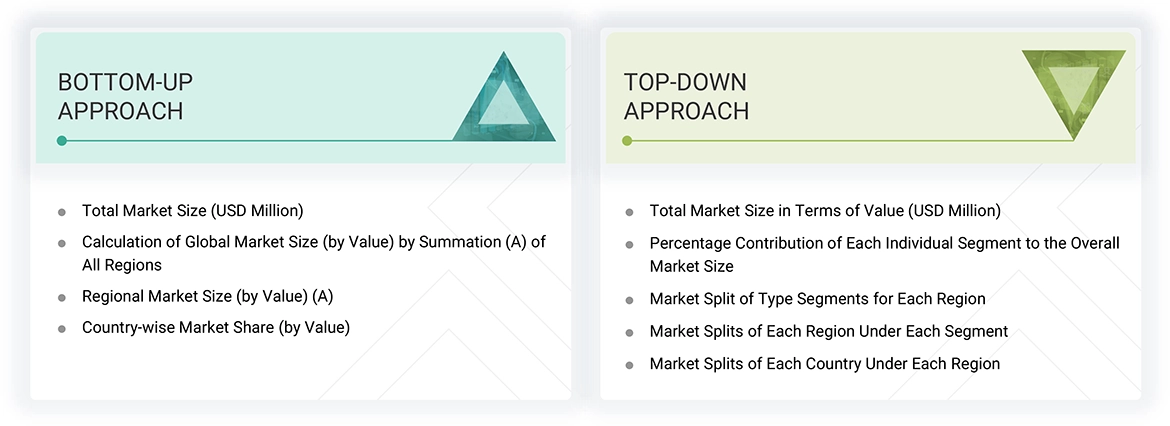
Data Triangulation
After arriving at the overall market size using the market size estimation processes, the market was split into several segments and subsegments. The data triangulation and market breakdown procedures were employed, wherever applicable, to complete the overall market engineering process and arrive at the exact statistics of each market segment and subsegment. The data was triangulated by studying various factors and trends from both, the demand and supply sides.
Market Definition
A roller pump or a peristaltic pump is a class of positive displacement pump that squeezes a flexible hose or tube within a circular housing to ensure contamination-free, clean fluid transfer. A revolving rotor with rollers or shoes successively compresses the tube, pushing fluid ahead in a controlled, pulsing action. These valve-less, seal-less pumps minimize contamination and maintenance since only the tube touches the liquid. They are ideal for accurate, gentle treatment in the food, water treatment, chemicals, and pharmaceutical industries. They are available as hose pumps for high-pressure, abrasive use and tube pumps for low-pressure, abrasive use. Reversible flow, dry-run capability, and self-priming are their key features.
Stakeholders
- Peristaltic pump manufacturers
- Raw material suppliers
- Converters & processors
- Distributors and traders
- Industry associations and regulatory bodies
- End users
Report Objectives
- To define, describe, and forecast the size of the global peristaltic pumps market based on type, flow rate, end-use industry, and region in terms of value and volume
- To provide detailed information on the significant drivers, restraints, opportunities, and challenges influencing the market
- To strategically analyze micromarkets concerning individual growth trends, prospects, and their contribution to the market
- To assess the growth opportunities in the market for stakeholders and provide details on the competitive landscape for market leaders
- To forecast the market size of segments and subsegments for North America, Europe, Asia Pacific, South America, and the Middle East & Africa
- To strategically profile key players and comprehensively analyze their market shares and core competencies
- To analyze competitive developments such as product launches, acquisitions, expansions, partnerships, and agreements in the peristaltic pumps market
- To provide the impact of AI/Gen AI on the market
Key Questions Addressed by the Report
Which factors are propelling the growth of the peristaltic pumps market?
Stringent regulations for wastewater treatment and increasing capacity additions, increasing global investments in new water & wastewater treatment facilities, expansion of pharmaceutical production globally, adoption of single-use technologies in bioprocessing, and rising food & beverage processing are the primary factors propelling the growth of the peristaltic pumps market.
What are the major challenges to the growth of the peristaltic pumps market?
Growing demand for customization from end-use industries, low scope of product differentiation, and frequent hose or tube replacements are the major challenges impacting the growth of the peristaltic pumps market.
What are the major opportunities in the peristaltic pumps market?
Rising capacity expansions and joint venture initiatives by end users in fast-growing markets and growing agriculture and renewable energy sectors are expected to create lucrative opportunities for peristaltic pumps market players in the coming years.
What are the major factors restraining the growth of the peristaltic pumps market?
The major factors restraining the growth of the peristaltic pumps market are the availability of large numbers of alternatives, fluctuations in raw material prices, and pulsed flow characteristics.
Who are the major players in the peristaltic pumps market?
The major players in the peristaltic pumps market include Watson-Marlow Fluid Technology Solutions (UK), Verder Group (Netherlands), ProMinent Group (Germany), Cole-Parmer Instrument Company, LLC (US), and Valmet (Finland).
Need a Tailored Report?
Customize this report to your needs
Get 10% FREE Customization
Customize This ReportPersonalize This Research
- Triangulate with your Own Data
- Get Data as per your Format and Definition
- Gain a Deeper Dive on a Specific Application, Geography, Customer or Competitor
- Any level of Personalization
Let Us Help You
- What are the Known and Unknown Adjacencies Impacting the Peristaltic Pumps Market
- What will your New Revenue Sources be?
- Who will be your Top Customer; what will make them switch?
- Defend your Market Share or Win Competitors
- Get a Scorecard for Target Partners
Custom Market Research Services
We Will Customise The Research For You, In Case The Report Listed Above Does Not Meet With Your Requirements
Get 10% Free Customisation














Growth opportunities and latent adjacency in Peristaltic Pumps Market